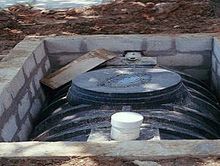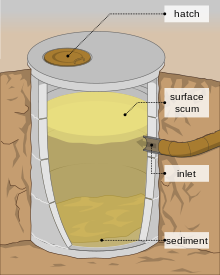Ralph Savage, CPHI, ROWP - Planner - Installer of Septic Sewage Systems - design, installation, evaluation, and subdivision approval. ralphsavage@hotmail.com Summerland BC 250.487.9120.
Septic tank

Septic tank and septic drain field
|
A septic tank is a key component of the septic system, a small scale sewage treatment system common in areas with no connection to main sewage pipes provided by local governments or private corporations. (Other components, typically mandated and/or restricted by local governments, optionally include pumps, alarms, sand filters, and clarified liquid effluent disposal means such as a septic drain field, ponds, natural stone fibre filter plants or peat moss beds.) Septic systems are a type of On-Site Sewage Facility (OSSF). In North America approximately 25% of the population relies on septic tanks; this can include suburbs and small towns as well as rural areas (Indianapolis is an example of a large city where many of the city's neighborhoods are still on separate septic systems). In Europe they are generally limited to rural areas only.
The term "septic" refers to the anaerobic bacterial environment that develops in the tank and which decomposes or mineralizes the waste discharged into the tank. Septic tanks can be coupled with other on-site wastewater treatment units such as biofilters or aerobic systems involving artificial forced aeration.[1]
Periodic preventive maintenance is required to remove the irreducible solids which settle and gradually fill the tank, reducing its efficiency. In most jurisdictions this maintenance is required by law, yet often not enforced. Those who ignore the requirement will eventually be faced with extremely costly repairs when solids escape the tank and destroy the clarified liquid effluent disposal means. A properly maintained system, on the other hand, can last for decades and possibly a lifetime.
Contents[hide] |
Description
A septic tank generally consists of a tank (or sometimes more than one tank) of between 4000 - 7500 litres (1,000 and 2,000 gallons) in size connected to an inlet wastewater pipe at one end and a septic drain field at the other. These pipe connections are generally made via a T pipe which allows liquid entry and exit without disturbing any crust on the surface. Today the design of the tank usually incorporates two chambers (each of which is equipped with a manhole cover) which are separated by means of a dividing wall which has openings located about midway between the floor and roof of the tank.
Wastewater enters the first chamber of the tank, allowing solids to settle and scum to float. The settled solids are anaerobically digested, reducing the volume of solids. The liquid component flows through the dividing wall into the second chamber where further settlement takes place, with the excess liquid then draining in a relatively clear condition from the outlet into the leach field, also referred to as a drain field or seepage field, depending upon locality.
The remaining impurities are trapped and eliminated in the soil, with the excess water eliminated through percolation into the soil (eventually returning to the groundwater), through evaporation, and by uptake through the root system of plants and eventual transpiration. A piping network, often laid in a stone filled trench (see weeping tile), distributes the wastewater throughout the field with multiple drainage holes in the network. The size of the leach field is proportional to the volume of wastewater and inversely proportional to the porosity of the drainage field. The entire septic system can operate by gravity alone, or where topographic considerations require, with inclusion of a lift pump. Certain septic tank designs include siphons or other methods of increasing the volume and velocity of outflow to the drainage field. This helps to load all portions of the drainage pipe more evenly and extends the drainage field life by preventing premature clogging.
An Imhoff tank is a two-stage septic system where the sludge is digested in a separate tank. This avoids mixing digested sludge with incoming sewage. Also, some septic tank designs have a second stage where the effluent from the anaerobic first stage is aerated before it drains into the seepage field.
Waste that is not decomposed by the anaerobic digestion eventually has to be removed from the septic tank, or else the septic tank fills up and undecomposed wastewater discharges directly to the drainage field. Not only is this bad for the environment, but if the sludge overflows the septic tank into the leach field, it may clog the leach field piping or decrease the soil porosity itself, requiring expensive repairs.
How often the septic tank has to be emptied depends on the volume of the tank relative to the input of solids, the amount of indigestible solids and the ambient temperature (as anaerobic digestion occurs more efficiently at higher temperatures). The required frequency varies greatly depending on jurisdiction, usage, and system characteristics. Some health authorities require tanks to be emptied at prescribed intervals, while others leave it up to the determination of the inspector. Some systems require pumping every few years or sooner, while others may be able to go 10–20 years between pumpings. Contrary to what many believe, there is no "rule of thumb" for how often tanks should be emptied. An older system with an undersized tank that is being used by a large family will require much more frequent pumping than a new system used by only a few people. Anaerobic decomposition is rapidly re-started when the tank re-fills.
A properly designed and normally operating septic system is odour free and, besides periodic inspection and pumping of the septic tank, should last for decades with no maintenance.
A well designed and maintained concrete, fibreglass or plastic tank should last about 50 years.[2]
Potential problems
- Excessive dumping of cooking oils and grease can cause the inlet drains to block. Oils and grease are often difficult to degrade and can cause odour problems and difficulties with the periodic emptying.
- Flushing non-biodegradable items such as cigarette butts and hygiene products such as sanitary towels and cotton buds will rapidly fill or clog a septic tank; these materials should not be disposed of in this way.
- The use of garbage disposers for disposal of waste food can cause a rapid overload of the system and early failure.
- Certain chemicals may damage the working of a septic tank, especially pesticides, herbicides, materials with high concentrations of bleach or caustic soda (lye) or any other inorganic materials such as paints or solvents.
- Roots from trees and shrubbery growing above the tank or the drainfield may clog and/or rupture them.
- Playgrounds and storage buildings may cause damage to a tank and the drainage field. In addition, covering the drainage field with an impervious surface, such as a driveway or parking area, will seriously affect its efficiency and possibly damage the tank and absorption system.
- Unsupervised septic tanks may cause serious injury or death to children playing nearby.
- Excessive water entering the system will overload it and cause it to fail. Checking for plumbing leaks and practicing water conservation will help the system's operation.
- Over time biofilms develop on the pipes of the drainage field which can lead to blockage. Such a failure can be referred to as "Biomat failure".
- Septic tanks by themselves are ineffective at removing nitrogen compounds that can potentially cause algal blooms in receiving waters; this can be remedied by using a nitrogen-reducing technology,[3] or by simply ensuring that the leach field is properly sited to prevent direct entry of effluent into bodies of water.
- Historically at least, not all varieties of toilet paper were suitable for disposal in a septic tank as they did not deteriorate sufficiently (or, at least at some points in history, some toilet paper was specifically marked as suitable for use in septic systems and some was not).
Environmental issues
Some pollutants, especially sulfates, under the anaerobic conditions of septic tanks, are reduced to hydrogen sulfide, a pungent and toxic gas. Likewise, methane, a potent greenhouse gas is another by-product. Nitrates and organic nitrogen compounds are reduced to ammonia. Because of the anaerobic conditions, fermentation processes take place, which ultimately generate carbon dioxide and methane.
The fermentation processes cause the contents of a septic tank to be anaerobic with a low redox potential, which keeps phosphate in a soluble and thus mobilized form. Because phosphate can be the limiting nutrient for plant growth in many ecosystems, the discharge from a septic tank into the environment can trigger prolific plant growth including algal blooms which can also include blooms of potentially toxic cyanobacteria.
Soil capacity to retain phosphorus is large compared with the load through a normal residential septic tank. An exception occurs when septic drain fields are located in sandy or coarser soils on property adjoining a water body. Because of limited particle surface area, these soils can become saturated with phosphate. Phosphate will progress beyond the treatment area, posing a threat of eutrophication to surface waters.[4]
In areas with high population density, groundwater pollution levels often exceed acceptable limits. Some small towns are facing the costs of building very expensive centralized wastewater treatment systems because of this problem, owing to the high cost of extended collection systems.
To slow development, building moratoriums and limits on the subdivision of property are often imposed. Ensuring existing septic tanks are functioning properly can also be helpful for a limited time, but becomes less effective as a primary remediation strategy as population density increases.
Trees in the vicinity of a concrete septic tank have the potential to penetrate the tank as the system ages and the concrete begins to develop cracks and small leaks. Tree roots can cause serious flow problems due to plugging and blockage of drain pipes, but the trees themselves tend to grow extremely vigorously due to the continuous influx of nutrients into the septic system.
Ralph Savage, CPHI, ROWP - Planner - Installer of Septic Sewage Systems - design, installation, evaluation, and subdivision approval. ralphsavage@hotmail.com Summerland BC 250.487.9120.





Comments (0)Subscribe to CommentsComment